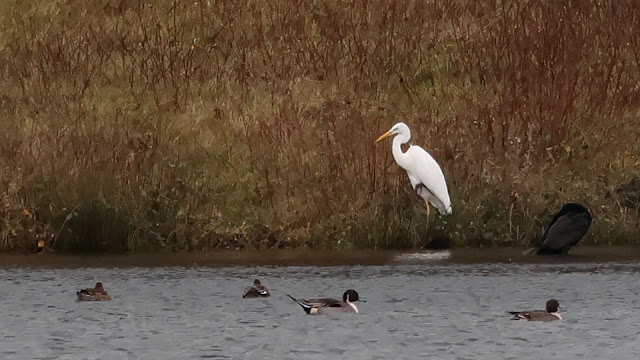I met Ian at the entrance to Blashford Lakes, a reserve we do not visit that often these days, but we were here for a drake Ring-necked Dove that had been found on one of the lakes last weekend. We decided to walk through the reserve and around the footpaths to Linbrook Lake east. We passed the Woodland and Ivy Lake South Hide and then crossed the boardwalk. Just before the path goes onto the road there was a large gathering of Long-tailed Tits in the trees and bushes. Other birds seem to follow the noisy Long-tailed Tits so we decided to stop and watch as the tits moved through the branches.
On reaching Linbrook Lake East there was a large group of Tufted Duck. Working through them it didn't take long to locate he Ring-necked Duck, preening amongst the Tufties. We could only view from the path, the area around the lake privately owned. To start with we were also peering through the branches.
Then from nowhere, as we watched the Ring-necked Duck two pairs of Goosander appeared.
A nice drake and the red head female.
Then it was back to the Ring-necked Duck as it mixed with the drake Tufted Ducks.
We intended to visit later, but first walked to the Lapwing Hide overlooking Ibsley water. From the hide there was very little, looking out across the lake we could see huge flocks of duck, but not clear what they were. A female Goldeneye appeared and gradually made its way towards us which provided the opportunity to photograph a duck that is notorious for keeping its distance.
A platform to the left of the hide had a dead deer on it. I am sure the reserve is hoping to attract the White-tailed Eagles, but today it had brought in a Buzzard and Magpie
We walked back to the cars and had some lunch. Siskin were feeding in the alders above us, but there was no sign of any thrushes which I had expected to see.
After lunch we walked to the Woodland Hide. Its fair to say there were more birds in my garden when I got home than on the feeders there. A Blue and Great Tit and a couple of Chaffinches was all we saw.
So we then walked around to the Ivy Lake North hide, inside this is what we found.
Windows that open at the front and are clear!
I have named this hide the worst hide in the world and was given so many reasons as to why the hide didn't have windows that opened, but it would seem that they have finally realised it was not fit for purpose and did something about it.
All that said there were the duck, distantly and a few Siskin in the surrounding trees, but we could see them without having to lean out of the side windows.
From the hide we walked around to the clearing in the wooded area where there were more feeders without any birds on them. It was very strange, maybe it was the mild conditions or perhaps the abundance of natural food about.
We decided to finish in the Tern Hide, but things did not get any better, the wind was blowing strongly from the north west and all the duck were in the north west corner sheltering. The most numerous duck was the Pintail, there was easily 500 all over the water, maybe more.
The water levels were high and all the islands and spits were covered, this may be the reason why there were no large gulls, or even Black-headed. Two Lesser Black-backed Gulls made an appearance, but must have received a message that everyone else were roosting somewhere else and flew off.
There were two Great Egret along the shore.
As well as the Pintail there were good numbers of Wigeon with Shoveler and Gadwall. Diving ducks were represented by Tufted Duck and two pairs of Goldeneye.
Every so often the duck would all fly off and circle the lake, we couldn't find any predator reason for this.
It was two o'clock and the light was going, it didn't look like the gulls were going to come so we decided to call it a day.
There was the feeling that the day was a wash out, mainly due to the dark and gloomy conditions that were not good for photography, but there was the Ring-necked Duck which was a first in Hampshire for me so it wasn't all bad




































No comments:
Post a Comment